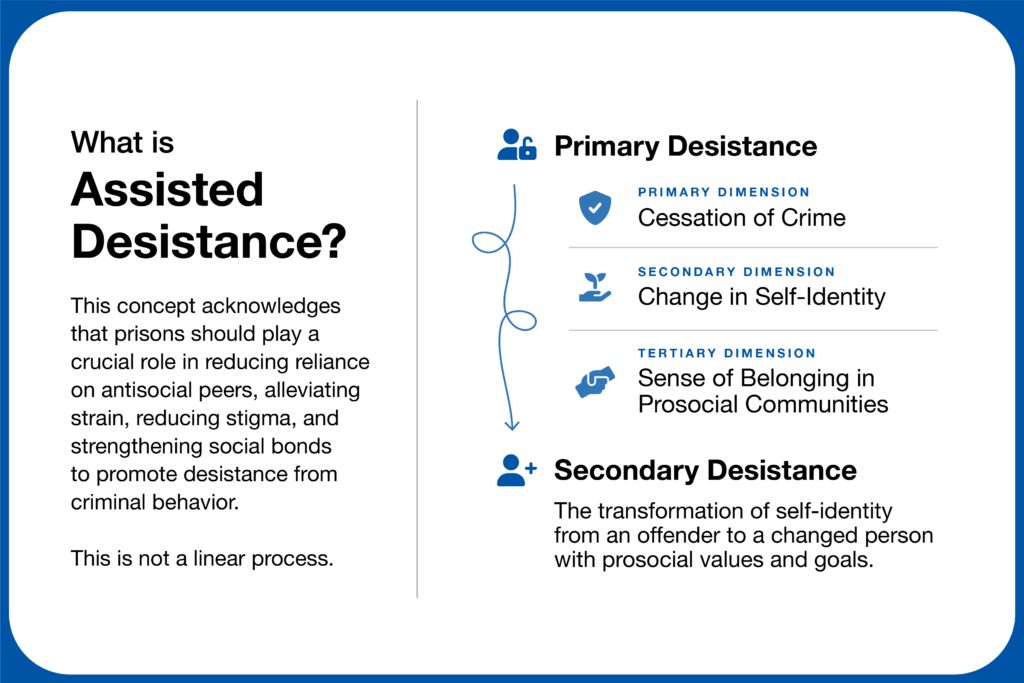
INTRO
Background
The criminal justice system has long relied on punitive measures, including incarceration, as a means of deterring criminal behavior. However, mounting evidence suggests that these harsh approaches may not effectively facilitate the rehabilitation and reintegration of offenders into society.
In light of this, a recent study conducted in New South Wales, Australia, has taken a significant step towards understanding how prisons can actively support individuals in their journey towards desisting from criminal activities. The study introduces the Macquarie Assisted Desistance Instrument (MADI), a self-report measure designed to assess the extent to which prisons contribute to the desistance process. This article delves into the key findings and implications of the study, shedding light on the potential for positive change within correctional facilities.
The Concept of Assisted Desistance
A fundamental premise of the study is the concept of "assisted desistance." This concept acknowledges that prisons should play a crucial role in reducing reliance on antisocial peers, alleviating strain, reducing stigma, and strengthening social bonds to promote desistance from criminal behavior. It recognizes that assisted desistance is not a linear process but rather involves primary (cessation of crime), secondary (change in self-identity), and tertiary (sense of belonging in prosocial communities) dimensions. Secondary desistance, which involves the transformation of self-identity from an offender to a changed person with prosocial values and goals, takes center stage in the study.

The Importance of Social Support
The study underscores the significance of social-relational factors in the desistance process. Recognition, encouragement, trust, and support from law-abiding citizens and key institutions are identified as critical in facilitating desistance. The concept of generativity and retroflexive reformation, wherein individuals help others to do good, is also linked to successful desistance.
Development and Validation of MADI
To measure the extent to which prisons support desistance processes, the researchers developed the MADI. This instrument underwent rigorous psychometric testing, including exploratory factor analysis and confirmatory factor analysis. The results indicated that the MADI, with its 18 items, consistently measured the intended construct of assisted desistance. It demonstrated excellent internal consistency reliability and showed strong associations with measures of hope and self-efficacy, confirming its convergent validity. Furthermore, the instrument was able to maintain its factor structure across different populations, allowing for meaningful comparisons between groups.
Perceptions of Assisted Desistance
The study revealed intriguing differences in perceptions of assisted desistance between different groups within the prison setting. Staff members perceived themselves to be providing more assistance than residents reported. Moreover, differences were observed between First Nations and non-First Nations participants, particularly at one of the correctional centers studied. These disparities underline the need for a nuanced understanding of the dynamics within prisons and suggest that tailored approaches may be required to address specific groups' needs.
Factors Predicting Assisted Desistance
Regression analysis showed that age and prison site significantly predicted assisted desistance scores for staff, with older staff members and those at a particular correctional center perceiving lower levels of assisted desistance. However, for residents, none of the demographic variables significantly predicted assisted desistance scores. These findings emphasize the complexity of perceptions regarding assisted desistance and hint at the importance of context-specific interventions.
Implications for Policy and Practice
The MADI holds promise as a tool to assess the extent to which prisons contribute to assisted desistance. It can provide valuable insights for policymakers and practitioners seeking to improve rehabilitative practices within correctional facilities. The study's findings also underscore the importance of considering individual and group differences in perceptions of assisted desistance and addressing potential disparities within the prison system.
Limitations and Future Directions
While the study represents a significant step forward in understanding assisted desistance within the prison context, it acknowledges certain limitations. Future research should aim to link assisted desistance scores with post-release outcomes to determine the instrument's predictive validity. Additionally, the MADI should be validated with diverse populations, including women in prison, to ensure its applicability across different settings.
Conclusion
In a criminal justice landscape marked by concerns about the efficacy of punitive measures, the Macquarie Assisted Desistance Instrument (MADI) offers hope. This innovative tool provides a means to assess and improve the extent to which prisons actively contribute to the desistance process. By emphasizing the importance of social support, recognizing disparities in perceptions, and highlighting the need for tailored interventions, this study paves the way for more effective, rehabilitative practices within correctional facilities. Ultimately, it is a call to action for a criminal justice system that seeks to promote lasting positive change among justice-involved individuals.
Sources: de Vel-Palumbo, M., Halsey, M., & Day, A. (2023). Assisted Desistance in Correctional Centers: From Theory to Practice. Criminal Justice and Behavior, 0(0).
https://doi.org/10.1177/00938548231193313

